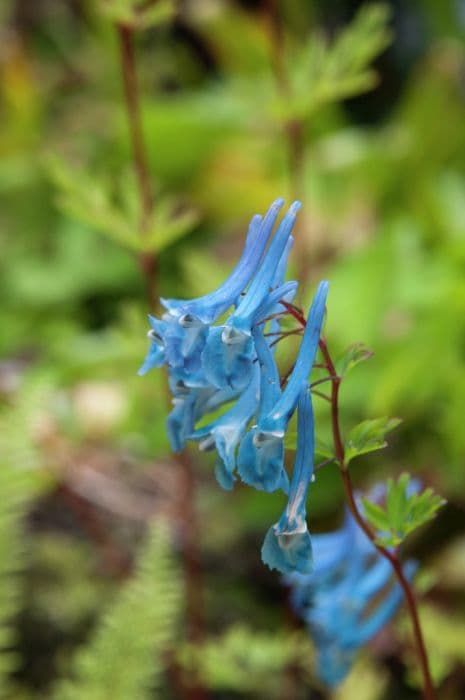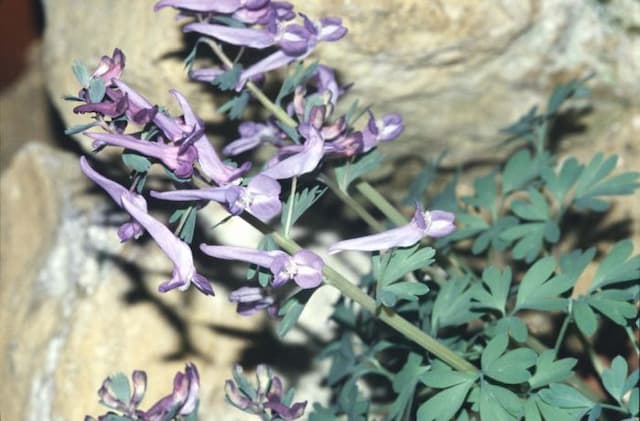Oriental Poppy Papaver (Oriental Group) 'John III'

ABOUT
Papaver, commonly known as Oriental Poppy 'John III', is a perennial flowering plant that showcases a stunning visual display. Its most striking feature is the large, showy blooms which exhibit a vivid color palette often dominated by shades of red, pink, orange or even white. The flowers have a delicate, tissue paper-like appearance, with petals that are slightly ruffled or crinkled at their edges, exuding a sense of depth and texture. At the center of each bloom is a dark, often black or purple, blotch which creates a bold contrast with the brighter petal colors. The blooms are borne on singular, upright stalks that rise above the foliage, and each flower is crowned with a whorl of prominent stamens, featuring anthers that add a sprinkle of black or dark-toned pollen to the visual mix. The foliage of the Oriental Poppy 'John III' is equally attractive, being deeply lobed and featuring a rich, green color. The leaves may have a hairy texture, adding to the tactile quality of the plant. As the plant goes through its growth cycle, it first puts forth a basal clump of leaves that stay close to the ground, creating a mound of greenery. Post blooming, these plants are known to enter a period of dormancy in hot weather, wherein the foliage may die back, leaving space in the garden for surrounding plants to fill in. Through its life cycle, the Oriental Poppy 'John III' adds rhythm and dramatic flair to garden spaces, drawing in viewers with its flamboyant blooms and sculptural foliage.
About this plant
 Names
NamesSynonyms
Oriental Poppy, Perennial Poppy.
Common names
Papaver orientale 'John III'.
 Toxicity
ToxicityTo humans
Oriental poppy, while beautiful, can be harmful if ingested by humans. Although toxicity is generally considered low, consuming this plant may lead to discomfort or symptoms such as nausea, vomiting, or diarrhea. Ingestion of large quantities could potentially cause more serious issues such as respiratory depression or central nervous system effects. Avoid eating any part of the plant to prevent possible negative health consequences.
To pets
Oriental poppy can also be toxic to pets if consumed. Symptoms of poisoning in pets can include gastrointestinal upset, such as vomiting and diarrhea. Depending on the amount ingested, more severe symptoms could occur, which might include changes in heart rate, sedation, or an allergic reaction. As with humans, it is best to keep pets away from the plant to avoid any ingestion and potential toxicity.
 Characteristics
CharacteristicsLife cycle
Perennials
Foliage type
Deciduous
Color of leaves
Green
Flower color
Varied
Height
2-3 feet (0.6-0.9 meters)
Spread
1-2 feet (0.3-0.6 meters)
Plant type
Herb
Hardiness zones
3-7
Native area
Asia
Benefits
 General Benefits
General Benefits- Attracts Pollinators: The plant produces large, colorful flowers that attract bees, butterflies, and other pollinating insects, enhancing biodiversity.
- Ornamental Value: With its striking flowers, Papaver (Oriental Group) 'John III', commonly known as Oriental poppy, adds aesthetic appeal to gardens and landscapes.
- Drought Tolerance: Once established, Oriental poppies are quite drought tolerant, which can be beneficial in regions with water restrictions or dry climates.
- Low Maintenance: These perennials require minimal upkeep once established, making them suitable for gardeners who prefer low-maintenance plants.
- Seasonal Interest: Oriental poppies provide a burst of color in late spring to early summer, creating seasonal interest in the garden.
- Deer Resistance: They are generally resistant to deer, which is helpful in areas where deer browsing can be a problem for gardens.
 Medical Properties
Medical PropertiesThis plant is not used for medical purposes.
 Air-purifying Qualities
Air-purifying QualitiesThis plant is not specifically known for air purifying qualities.
 Other Uses
Other Uses- Oriental poppy petals can be pressed and used in craft projects like creating natural decor for handmade papers or bookmarks, providing an organic, delicate embellishment.
- The seed pods of Oriental poppies, once dried, can be integrated into flower arrangements or used as a decorative element in wreaths and dried floral displays.
- Extracts from Oriental poppies can be used as colorants for soaps and fabric dyes, offering a range of warm, earthy tones.
- Oriental poppies can serve as a teaching tool in horticulture classes, showcasing the plant's life cycle from seed to bloom to seed pod.
- The bright blossoms of Oriental poppies attract pollinators, so they can be planted in gardens to support bee populations.
- The strong visual appeal of Oriental poppies can be utilized in photography and painting as a subject for artists seeking vibrant natural beauty.
- Oriental poppy seeds can be used in baking, as an addition to bread, cakes, and muffins, providing a nutty flavor and a decorative touch.
- Gardeners can use the bare stems and foliage of Oriental poppies after flowering as a green backdrop to contrast with summer blooming plants.
- Dried Oriental poppy petals can be included in potpourri mixes, contributing a subtle fragrance and a pop of color.
- As an educational resource, the different stages of Oriental poppy growth can be used to teach about the importance of plant structure and anatomy.
Interesting Facts
 Feng Shui
Feng ShuiThe Oriental Poppy is not used in Feng Shui practice.
 Zodiac Sign Compitability
Zodiac Sign CompitabilityThe Oriental Poppy is not used in astrology practice.
 Plant Symbolism
Plant Symbolism- Remembrance: Poppies, including the Oriental Poppy 'John III', have long been used as a symbol of remembrance, particularly in relation to soldiers who have died during warfare. This symbolism is especially prominent in association with Remembrance Day, celebrated in Commonwealth countries.
- Peace: After World War I, poppies became a symbol of peace, with their bright red colors representing the blood spilled in war but also the hope for a peaceful future.
- Rest: The Oriental Poppy 'John III' can also symbolize rest and eternal sleep, a metaphor often linked to the opiate properties of some poppy species, which were used historically for sedation.
- Beauty and Success: The spectacular and ornamental nature of the poppy's bloom can symbolize beauty and success in one's endeavors. The poppy's lush appearance can signify the achievement of success through beauty or creativity.
- Resilience: Poppies are known for their ability to thrive in difficult conditions, symbolizing resilience and the capacity to recover from adversity.
 Water
WaterOriental poppies, including 'John III', should preferably be watered in the early morning to allow foliage to dry out during the day, reducing the risk of fungal diseases. During the growing season, ensure that the plant receives approximately 1 inch of water per week, whether from rainfall or manual watering. The soil should be allowed to dry out slightly between waterings, but not allowed to become parched. Overwatering or allowing the plant to sit in water can lead to root rot. During dormancy in the late summer, watering can be reduced.
 Light
LightOriental poppies like 'John III' perform best in full sun conditions. They require a minimum of six hours of direct sunlight each day. The best spot for this plant is in a garden bed that is exposed to direct sunlight for most of the day without any shade from buildings or trees obstructing them.
 Temperature
TemperatureOriental poppies, including 'John III', thrive in temperate climates with cold winters and warm summers. They can survive winter temperatures down to -30°F while the maximum temperature they can tolerate is around 90°F. The ideal growing temperature range during the daytime is between 60°F and 75°F.
 Pruning
PruningOriental poppies such as 'John III' should be pruned back after the flowers have faded and the foliage has turned yellow, typically in midsummer. This pruning encourages new basal growth and helps to maintain a tidy appearance as the plant enters dormancy. Deadheading, or removing spent flowers, can prolong the blooming period. The best time for major pruning is after flowering, as the plant prepares for dormancy.
 Cleaning
CleaningAs needed
 Soil
SoilOriental poppies like 'John III' thrive best in well-drained soil with a pH ranging from 6.5 to 7.5. A soil mix containing equal parts garden soil, compost, and coarse sand or perlite will ensure adequate drainage and fertility.
 Repotting
RepottingOriental poppies like 'John III' do not tolerate repotting well due to their deep taproots and are usually not repotted once established.
 Humidity & Misting
Humidity & MistingOriental poppies such as 'John III' are tolerant of a wide range of humidity levels and do not have specific humidity requirements.
 Suitable locations
Suitable locationsIndoor
Provide full sun, well-draining soil, and avoid over-watering.
Outdoor
Plant in full sun, well-drained soil, and water deeply but infrequently.
Hardiness zone
3-9 USDA
 Life cycle
Life cycleThe Oriental Poppy 'John III' starts its life cycle when the seeds germinate in late spring or early summer, after experiencing a period of cold stratification which breaks their dormancy. The seedlings establish a rosette of leaves during their first growing season, focusing on developing a strong root system. In the following spring, the oriental poppy produces a flowering stalk from the center of the rosette, and by early to mid-summer, it blooms with large, colorful flowers that are typically red or orange with a black center. After pollination, often by bees or other insects, the flowers fade and the plant forms seed pods which eventually dry and release seeds for the next generation. In late summer, the plant goes dormant, with the above-ground foliage dying back, and it remains dormant throughout the winter. The cycle begins anew with the next spring's growth of new foliage, leading up to another blooming period.
 Propogation
PropogationPropogation time
Spring
Propogation: The Oriental Poppy 'John III' is typically propagated through seed sowing. Sowing can be done in late winter or early spring, once the risk of frost has subsided, directly into the ground where they are to grow. The seeds should be scattered onto well-prepared soil and lightly covered with a thin layer of soil or compost. Good contact with the soil is key for germination, which usually takes anywhere from one to three weeks. As Oriental Poppies dislike root disturbance due to their long taproots, it is advantageous to sow them in their final position or in biodegradable pots that can be planted whole into the ground. Thin the seedlings to allow proper development, spacing them about 15 to 18 inches (38 to 45 centimeters) apart.









